Gorgo (1961)
Directed by: Eugène Lourié
Written by: Daniel James, Robert L. Richards
Starring: Bill Travers, Christopher Rhode, Vincent Winter, William Sylvester
UK
AVAILABLE ON BLU-RAY [REGION ‘A’ ‘ONLY], DVD and DIGITAL
RUNNING TIME: 79 mins
REVIEWED BY: Dr Lenera
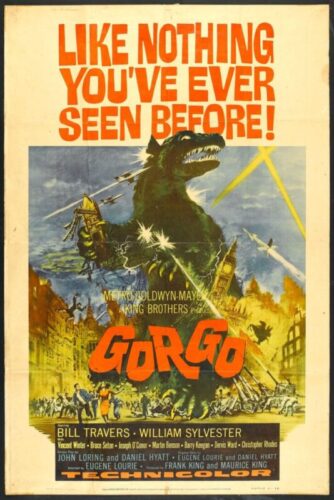
Captain Joe Ryan is salvaging for treasure off the coast of Ireland when a volcano erupts, nearly sinking his ship. Ryan and his First Officer and friend, Sam Slade, take the ship to Nara Island for repairs where they meet orphan Sean, but discover that the Harbour Master, Mr McCartin, has a collection of illegally salvaged gold from the harbour, and also that several divers have mysteriously disappeared. Another diver dies seemingly from “fear”, then a group of fisherman are attacked by a large creature but drive it off. Despite Sean telling them that they’ve made a mistake, Ryan capture the creature and take it London where it’s sold to Dorkin’s Circus in Battersea Park. However, two scientists inform them that the creature, named “Gorgo” by Dorkin, is an infant – meaning that a parent might be out there….
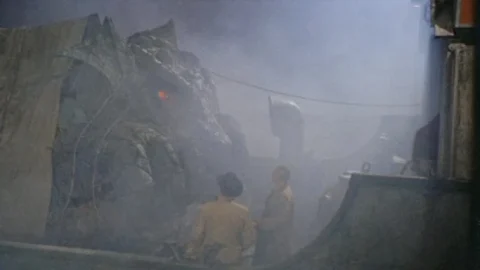
One of my fondest movie-watching memories as a kid was when BBC2 showed four creature features over four weeks on a Thursday evening; for the first time I got to experience the pleasures of the 1933 King Kong [still the greatest giant monster movie of all time, sorry Godzilla], The Beast From 20 000 Fathoms, Gorgo and Mighty Joe Young. While King Kong was of course the most thrilling, it was Gorgo that affected me most. The third of the Eugene Lourie monster pics, following The Beast From 20 000 Fathoms and The Giant Behemoth, and the most lavish, is also the cleverest, designed to please that kid who loves monsters, which makes it utterly bonkers that it was given an ‘X’ certificate in the UK [it was considered to be “too loud” for children]. As well as having a young boy as an important protagonist, it goes one step further than those other films where we slightly like the huge menace that’s causing death and destruction, and makes the creature into a mum coming to get her kid back who’s been imprisoned by those nasty humans. It even features a scene where Sean, the little orphan, grins with joy as London is being smashed to pieces right by where he is. It also has an extremely snappy pace and by far the most extensive monster footage and city-wrecking out of the three films in an absolute orgy of special effects, though some of the many opticals don’t look so good in High Definition and the plethora of stock footage is very obvious, even more so considering the gorgeous colour this film is shot in. They decided to go for Suitmation for this one, which aided the budget immensely, and came up trumps, with both Gorgo and his mother impressive and memorable creations which feature in some fantastic shots which more than make up for the things that don’t work or are rather laughable when seen as an adult, such as a reporter who with hyperbole comments on the mayhem that’s going on all around him with seemingly no fear or common sense; in one shot rubble is falling right behind him!
Tbe genesis of Gorgo can be traced back to 1953 when, after seeing her father’s The Beast From 20 000 Fathoms, Lourie’s daughter complained “Daddy, you killed the big nice beast”. So Lourie was easily lured back to make a third monster movie, the second being The Giant Behemoth, by the King Brothers, who promised him a big budget. He wrote the screenplay with Daniel James and even designed the monsters. This was originally called Kuru Island, and be a collaboration with an [unknown] Japanese studio and be set in Japan and the South Seas; after all, the King Brothers [Frank, Herman and Maurice] hadn’t long had a big success with their distributing of Toho’s Rodan. This fell through, so the setting was then changed to Australia, but that was rejected because the Kings decided that audiences “wouldn’t care” if a monster attacked Australia! Then France was considered, but they wanted Paris to be attacked and that was too far from the sea. So Britain was eventually agreed upon. Robert L. Richards and the Kings made some significant alterations to the script, such as making the humans less sympathetic and adding what Lourie called “violent action and illogical development”. Location footage was shot at Bulloch Harbour and Colliemore Harbour, both near the County Dublin town of Dalkey, and of course London, though very little by the looks of it. Other scenes were filmed at the MGM-British Studios in Borehamwood, Hertfordshire. The release was held up for nearly two years because the Kings hadn’t paid their bills. Gorgo went on to make a lot of money, even in Japan where it had its premiere in Tokyo. Six years later, Japan’s [but Nikkatsu not Toho or Daiei] Gappa The Triphibian Monster [aka the inaccuRate Monster From A Prehistoric Planet] featured both parents trouncing Japan in search for their kidnapped child.
Both the last two Laurie creature features started things off early, but this one really immediately gets down to business where the ship that we first see nears some very bubbly waves. “The people are getting edgy, and so am I”, “I know these waters well Sam, I’ve never seen the like of this before” is said before a rock rises ominously out of the water. A good example of the budget not quite stretching to cover everything is here; when we cut to the rock again it’s already got lava spewing out of it, we don’t see it beginning. The ship is nearly sunk in a pretty exciting sequence of its type, despite it containing something that may be distracting for viewers not used to the way older movies were made; lots of blue lines around characters who are frequently matted into backgrounds which can be grainy. The ship is scuttled right by Nara Island and, as they row ashore, they come across dead fish-like creatures. Knocking on the first house sees the door answered by young Sean who oddly has a lage collection of Viking relics which include one that bears the image of a creature that Sean calls “Ogra, the sea spirit”. The grouchy, uncooperative Harbour Master Mr McCartin claims that they need a permit to be there for more than twenty-four hours, but is at least willing to give them fresh water. A diver clutching two gold coins surfaces to then die; obviously McCartin doesn’t want his visitors around for a reason. Gorgo is first seen underwater in an otherwise rather unnecessary diving sequence, then, when the whole fleet of fishermen begin to set out to kill this menace, rises from the water to topple lots of boats and even go on land before eventually being driven away by fire. Yep, we’re straight into full-on monster action already, and it’s only been fifteen minutes!
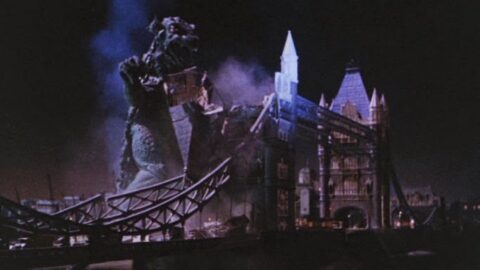
Joe blackmails McCartin into letting him kidnap the creature, saying that he’ll tell the authorities about a secret stash of gold he has otherwise which he makes him open. Now we get the first of several variations on scenes in The Beast From 20 000 Fathoms, with Joe going down in a diving bell to lure Gorgo to where he can be trapped with nets, though overall this films is far less imitative of the 1954 film than The Giant Behemoth was. Two top Irish palaeontologists turn up and wish to study the creature, bit no, Joe and Sam, who are only interested in profiteering, have already sold it to Dorkin’s Circus. At least they follow the advice to keep its skin wet, but while on the way to London, Sean is found trying to untie it. The palaeontologists try again, rightfully claiming that Joe and San stole it, while the Irish government are about to embark on legal proceedings against them, but Joe, Sam and Dorkin don’t care, except for following their warning that it should be tranquilised. The poor creature is paraded around London to full media attention while Dorkin names it “Gorgo” after the Gorgon Medusa with its deadly look, which is a bit off, but never mind. We really pity this imprisoned animal, even when it briefly breaks loose and kills a man. “Something’s gonna happen, I can feel it” says Sam, and sure enough, in perhaps the most menacing and atmospheric sequence of the film, a much larger version of Gorgo comes on to the island. Her rampage is cut short; so is some naval action we partly just hear about, but nonetheless what follows is hugely impressive in scale and usually, though not always, in execution.
Mother Gorgo smashes several London landmarks and a lot of buildings, and really does go to for them; it doesn’t look like they’re just in her way. The miniatures are very detailed and crumble very convincingly, unlike in some films. What’s curious is that, even though we’re largely on Mother Gorgo’s side, there’s a lot of emphasis on how this affects the populace, with a lot of believable evacuation footage which goes from orderly to ugly panic, while people are also burnt to death and even jump out of windows before Mother Gorgo wrecks the building. There are a surprising amount of shots of rubble falling on and crushing people too, though three of them are the same, which leads me to comment on the large amount of repeated footage, both new and stock. These cutaways tend to be quick and aren’t always noticeable unless you’re concentrating very hard, editor Eric Boyd-Perkins clearly doing his best with what he had, which may not have been enough, probably because the Kings thought up all this extra action after the budget had been set. It’s possible that a few scenes weren’t completed and had to be finished using stock material, which is usually army, navy and air force footage. Its roughness we can accept, but daytime shots when most of the events take place at night aren’t really forgiveable, and look out for a shot of a desert when we’re supposed to be in London, not to mention a continuity error during the rampage, which indicates that footage was moved around, not to mention one scene featuring shots in the wrong order. Sometimes people are poorly composited and a shot of painted human figures is just ridiculous. But there’s more that’s good, and Gorgo and Mother Gorgo are both endearing [love those floppy ears] and fearsome while chosen camera angles enhance their majesty. Their eyes, ears, mouths and tail were moved by hydraulic pistons inside the suits. Some images of Mother Gorgo are gorgeous, with fabulous use of colour as parts of the city are ablaze. Freddie Young did his usual excellent job of cinematography here.
The script remains vague as to the link between the boy and the monster[s], though we’re probably intended to assume that the monster that Sean has an engraving of is Mother Gorgo or, seeing as one wouldn’t have thought these creatures would live to that long, one of her ancestors [but then where’s the daddy?]. Joe and Sam seem like our heroes at first, but soon become rather dislikeable, only interested in money and caring not a hoot for the animal that they capture and sell to be exhibited. Hadn’t either of them seen King Kong? Sam begins to waver, gets drunk and tries to free Gorgo but is stopped in the nick of time by Joe, who’s never seen to undergo any form of redemption at all. This is quite unusual, and makes young Sean our real hero. He’s quite sensitively played by Vincent Winter. There are no women in the film aside from extras. Angelo Lavagnino’s score is easily the best of the three Lourie monster pics, with actually a melody being utilised, a nautically-tinged tune associated with Sean. While there’s still not a memorable monster theme, there’s some evocative underwater scoring and, despite this being by far the noisiest and most action-packed of the three Lourie films, a lot of holding back; much of the destruction surprisingly benefits from no music. The monster roars either sound like those of lions or the creatures emit slightly metallic ones much like a Japanese kaiju. It seems odd, but then again why should they be restricted to emitting just one sound? Despite very clear evidence of trying to do more then the budget allowed in places, and occasional clumsiness in execution, Gorgo remains a highlight of old school monster movie making, appealing directly to the young [or old] creature lover who’s always wanted to root for the monsters, and now unashamedly can. Sure, much carnage and many casualties result, but they shouldn’t have taken Gorgo away in the first place, should say?
Rating: 











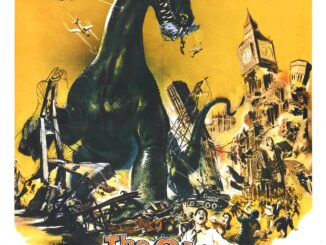
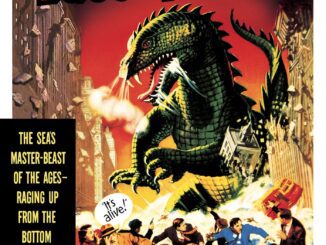
Be the first to comment